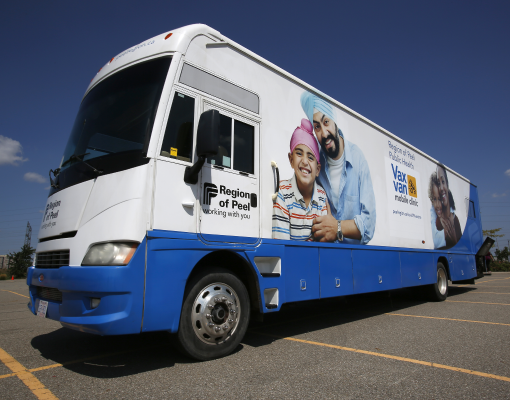
Peel Public Health tackles inequities in workplaces and increases access to worker protections during COVID-19
This Equity in Action story is distilled from an interview with Dr. Lawrence Loh (Medical Officer of Health) and Paula Smith (Advisor, Equity and Community Engagement) at Peel Public Health. The interview took place in September 2021, and its details should be considered within the context of that time period.
|
The story of the COVID-19 pandemic in Peel has ultimately been a story of how inequities impact health. Whether economic, sociodemographic, or ethnocultural, many of the disparities and inequities that existed in Peel prior to the arrival of COVID-19 lay fertile ground for the significant impacts Peel had to battle throughout the initial three waves of the pandemic. |
Not everyone can stay home when they are sick – and precarious work comes with heightened risk of COVID-19 exposure and infection.
We were originally conceived as a bedroom community to Toronto, built up around Canada’s busiest airport, Pearson Airport, with a huge goods movement and manufacturing industry. When we think about work environments and the systemic and avoidable challenges that existed there, a lot of that really came down to the nature of work in our community.
Many people who live in Peel work in jobs that could not be performed from home. Working in goods movement, distribution, or manufacturing entails in-person interaction and potentially close contact with other individuals where precautions can’t always be consistently maintained. On top of that, many of those jobs have come to be done by newer Canadians and racialized Canadians, some of the most vulnerable people in our community. And, oftentimes, they’re at the hands of employers who lack specific incentives or a certain scrupulousness to ensure that they’re adequately protected even during normal times.
Examples include temporary and agency workers, who often work in different settings, and who would often take calls to come in for work because they don’t have any other sort of steady employment. Some residents worked for employers that would not enact specific precautions, either because they were skeptical of COVID, or felt precautions were unnecessary and hurt their bottom line. A review of our data found that 1 in 4 cases during the second wave were individuals who went to work while symptomatic. They often faced an impossible choice between adhering to public health measures or collecting their paycheck. Staying home meant not getting paid but showing up sick meant outbreaks could result. This wasn’t through any fault of their own; it became very clear throughout the pandemic response that these folks were beset by impossible choices in the midst of a system that essentially perpetuates the inequities and disparities that influence the choices that they make.
Standing up for workers who are precariously employed
We took a lot of steps in trying to resolve barriers and improve access to protective measures for people in our community.
We advocated for policy measures like paid sick leave and worker protections. Where people didn’t have paid sick leave, they would be less likely to isolate when they were sick, to not get tested or go for vaccination if they couldn’t get time off work. This was particularly true among temporary and agency workers and part-time workers, as they didn’t have the same workplace benefits or protections. We also partnered with community agencies to reach out to workers who are employed by agencies. We took an in-depth look at agency workers and advocated to the province to examine how to make controls more robust. And we worked with advocates to establish an isolation housing program, with the federal then provincial government, because we know many of the workers who work in these facilities often live together in congregate settings, which is where we also saw a lot of COVID-19 spread.
also saw a lot of COVID-19 spread.
We worked closely with Ontario Health Central Region to increase overall testing capacity and mobile testing capacity, and to provide barrier-free access to testing. There’s a large South Asian community in northeast Brampton. With the South Asian Task Force, we set up a specific culturally appropriate testing centre and it later became a vaccination centre.
Workplace safety is a shared responsibility between Public Health and Occupational Health and Safety. Occupational Health and Safety has the primary mandate in terms of preventive measures and policies around the employer’s responsibility to provide safe work. Public Health gets involved where there are outbreaks or specific health issues in a workplace that might threaten to spill over in the broader community. And that happened in our third wave when we enacted sections with the HPPA to require workplaces to report any two or more COVID cases within a 2-week period, and to close workplaces if there were more than five cases connected to them.
In addition, we worked closely with the Ministry of Labour and other provincial government departments to increase proactive workplace inspections in Peel. We had multi-ministry teams go out and check workplaces to ensure precautions were followed, and issue tickets and sanction employers if they weren’t.
Willingness to do things differently and acknowledging different lived experience
Because of the nature of the work in Peel, where many people are employed in shift work, or have non-traditional hours, when the vaccine rollout came, we implemented the province’s higher prioritization for essential workers. We instituted several workplace mobile clinics and overnight clinics for shift workers and those in the transportation industry. We set up occupation-specific vaccine clinics, like clinics where truck drivers and taxi drivers could drive up and get vaccinated.
Information sharing was another big part. We were one of the first health units in Ontario to start reporting workplace outbreaks by sector on our website, to highlight sectors that were having challenges. Our Communications Team supported tailored messaging, including a dedicated webpage for workplaces with education and resources in multiple languages. People could call our Peel Public Health contact centres to ask about workplace issues they were facing. We had to put this infrastructure in place for the work to happen. It’s more like background action, but it certainly proved to keep some of the wheels turning.
All of these efforts recognized that not everyone within the community had the same opportunity to protect themselves.
The news media did great at sharing stories about the inequities in workplaces to raise awareness. There was more public awareness and support for worker protection, that something had to be done in these places to stop spread and support vaccination. There was political support, with our mayors and local councillors advocating for better protections. For a moment, it seemed like there was a broad rallying of support and interest that helped push the importance of worker protection.
Learning what we can do better by listening to our community
 In the first wave we were so busy trying to get our heads around this new disease that to some extent our engagement with the community was limited. As we moved into the second wave though, we noticed there were members of the community expressing concerns around the response that had not been addressed. We reached out to them, and eventually we added community engagement to the portfolio of one of our Associate Medical Officers of Health. We shifted our focus to start working more with the community. It was a commitment to reach out to the community and understand what they were seeing on the ground, recognizing that not everyone’s experiences were the same. We made an extra effort to be out there in the community, listening to what they were talking about and doing so we could act and align efforts.
In the first wave we were so busy trying to get our heads around this new disease that to some extent our engagement with the community was limited. As we moved into the second wave though, we noticed there were members of the community expressing concerns around the response that had not been addressed. We reached out to them, and eventually we added community engagement to the portfolio of one of our Associate Medical Officers of Health. We shifted our focus to start working more with the community. It was a commitment to reach out to the community and understand what they were seeing on the ground, recognizing that not everyone’s experiences were the same. We made an extra effort to be out there in the community, listening to what they were talking about and doing so we could act and align efforts.
That speaks to what we would hope for in the future as a health unit that has advancing health equity as one of our strategic priorities. It is critical that, if you’re going to advance health equity, you need to understand the story behind the numbers and you need to understand what you’re seeing, whether it’s COVID or other health outcomes. And there are solutions that exist within the community. Ultimately the community is best placed to identify where extant recommendations or guidance is not working and/or where their insights are needed.
Community engagement was already an identified priority for Peel Public Health. COVID turbocharged our engagement, and our interest now is in figuring out how to take what we’ve started and sustain the relationships we’ve built into recovery to formalize this as part and parcel of our work knowing that it served us well in this emergency response. Engagement is critical to informing the choices and the decisions you’re making for the community. It helped us to prioritize our advocacy and programming by helping us understand the patterns we were seeing.
Public Health has long been the one piece that fits in a broader health and social service system, within the broader regional government. In thinking about engagement, though, we wonder how we will be able to integrate opportunities within a broader regional approach to do this even better, in a coordinated way, when working with community partners.
Two things we’d highlight in closing would be humility and trust. When we first reached out to people, a lot of them were mad. They were like, you never called us, you don’t know what’s going on, etc. But we had to recognize where that anger is rooted: in those inequities and the lack of attention that has traditionally been accorded to some of these diverse communities in our Region. Going in with a sense of humility and understanding that you are working together on a common goal is crucial. And so is trust. It takes a lot to build, and once you have it, you absolutely do not want to lose it. Because once you’ve lost it, it becomes that much more difficult to continue with the engagement or to really ensure that you’re able to make decisions or recommendations that would be supported by the community.
Lessons learned: |
|||
 |
|
||
|
|
Community engagement is essential to understand the stories behind the numbers and to work with diverse communities on tailored, culturally appropriate, and safe approaches within a comprehensive response.
|
||
|
|
Effective health equity interventions require partnering across levels and sectors (including local, regional, provincial and federal governments; health agencies; community organizations; employers) and better integrating efforts to reach shared goals.
|
||
Background:
Region of Peel - Delivering essential social services and infrastructure to 1.5 million residents and over 175,000 businesses in Brampton, Caledon and Mississauga.
To learn more about the initiative described in this story, contact the National Collaborating Centre for Determinants of Health at [email protected].
Do you have an idea for an Equity in Action story? If you have heard of other health equity-promoting COVID-19 pandemic response initiatives in Canada that we should share, please let us know.

